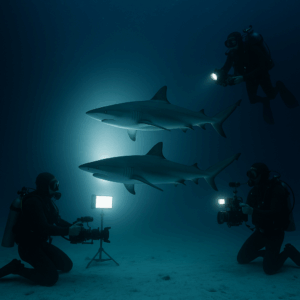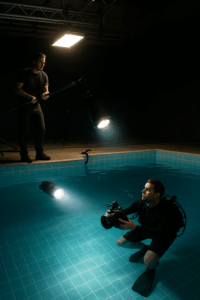Introduction
Lighting has always been an integral part of filmmaking, influencing everything from the mood and atmosphere to the clarity and visual aesthetics of a scene. From the early days of cinema, filmmakers have relied on various forms of artificial lighting to enhance their storytelling. However, as technology progresses, so too do the tools and methods used to light a set.
In this article, we will explore two of the most widely used lighting solutions in modern filmmaking: traditional floodlights and modern waterproof RGB+White LED fixtures. While traditional floodlights have been a staple of the film industry for decades, waterproof RGB+White LEDs are emerging as a versatile and more efficient option, particularly for outdoor and challenging environments.
We will compare these two lighting solutions in terms of performance, energy efficiency, flexibility, portability, and practicality in different filmmaking scenarios. By the end, filmmakers will have a clearer understanding of which lighting solution is most suitable for their specific production needs.
Overview of Traditional Floodlights
Traditional floodlights, often incandescent or halogen-based, are a key component of many large-scale film productions. These lights are known for their high output of intense, broad-spectrum light. Unlike spotlights, which concentrate light on a smaller area, floodlights are designed to illuminate large areas with an even spread of light.
Floodlights can be used for everything from lighting vast outdoor sets to creating dramatic lighting effects for specific scenes. Their high brightness makes them ideal for outdoor shoots, particularly in large or open spaces, such as stadiums, parking lots, or natural environments.
Benefits of Traditional Floodlights
Drawbacks

What are Waterproof RGB+White LEDs?
Waterproof RGB+White LEDs represent the next generation of lighting solutions for filmmakers, combining the benefits of both RGB (Red, Green, Blue) and white light in one fixture. These LEDs offer a broader spectrum of color options, from pure whites to vibrant colors, allowing for far greater creative flexibility.
One of the most notable features of these modern LEDs is their waterproof design, making them ideal for outdoor filming, particularly in rain or underwater scenes. Waterproof ratings (IP65 or higher) ensure that these lights can withstand harsh weather conditions, making them perfect for shoots in challenging environments.
Benefits of RGB+White LEDs
Key Technological Advantages

Brightness & Performance
Traditional floodlights typically offer very high lumen output, which makes them great for brightening large areas. However, they can struggle with providing the nuanced control of light that RGB+White LEDs offer.
RGB+White LEDs, while not always as bright as traditional floodlights, compensate by providing excellent color accuracy and the ability to adjust light intensity and color temperature. This makes them more versatile, especially for scenes requiring softer or warmer light tones.
Energy Efficiency & Cost
When it comes to energy consumption, RGB+White LEDs clearly outshine traditional floodlights. LEDs consume significantly less power, which results in lower electricity bills and less environmental impact over the long term. Their lower operational costs make them a better investment in the long run.
In comparison, traditional floodlights, with their high energy demands, are more expensive to operate and can contribute to higher costs on a large production.
Flexibility & Creativity
One of the standout features of RGB+White LEDs is their immense creative flexibility. Filmmakers can mix RGB colors to create unique effects or adjust the white balance to fit specific scene needs. This versatility allows for lighting changes without requiring multiple light sources or gels.
Traditional floodlights, on the other hand, are limited to fixed color temperatures and often require extra filters or gels to achieve the desired lighting effect, making them less adaptable.
Portability & Setup
Due to their compact size and lightweight design, RGB+White LEDs are easy to transport and set up on location. Traditional floodlights, especially older models, are often heavy, bulky, and require more manpower to transport and install.
Durability and Weather Resistance
Waterproof RGB+White LEDs excel in outdoor conditions, handling rain, snow, and even submersion in water (with proper equipment). Traditional floodlights, especially those without waterproofing, can be damaged by the elements and require extra protection when used outdoors.
Control and Automation
RGB+White LEDs often come with advanced control options such as wireless capabilities, DMX512 integration, and app-based controls. This makes it easy for filmmakers to adjust settings remotely, even during complex scenes with multiple light sources.
Traditional floodlights typically require manual adjustments, making them less convenient and harder to control during fast-paced shoots.
Outdoor & Water-Based Filming
Waterproof RGB+White LEDs are a game-changer for outdoor and water-based filming. Their ability to withstand the elements makes them ideal for beach, river, or underwater scenes. With traditional floodlights, filmmakers face challenges when it comes to using them in wet conditions, as they are not designed to be water-resistant.
On-Set Flexibility
RGB+White LEDs provide the flexibility needed for creative on-set work. Whether adjusting color temperatures to evoke different times of day or experimenting with different colors for mood, these LEDs make lighting adjustments quick and easy. Traditional floodlights, with their limited color control, fall short when trying to achieve these types of lighting effects.
Safety Considerations
Given the high heat output of traditional floodlights, safety precautions must be taken to prevent overheating, particularly in enclosed spaces. RGB+White LEDs generate little to no heat, significantly reducing the risk of accidents or discomfort on set.
Example 1: Traditional Floodlight Use in a Classic Outdoor Scene
One iconic example of traditional floodlight use is in the production of action scenes or large outdoor events. For instance, in films like The Dark Knight or Transformers, traditional floodlights have been used to create dramatic outdoor scenes at night, providing the sheer brightness required to illuminate large sets.
Example 2: Successful Use of Waterproof RGB+White LEDs in a Modern Film Production
In recent films such as Aquaman and Mad Max: Fury Road, waterproof RGB+White LEDs have played a pivotal role in creating stunning lighting effects. In Aquaman, underwater lighting is crucial for many scenes, and RGB+White LEDs provide the flexibility and waterproofing required to illuminate underwater action shots.
The future of film lighting lies in even more advanced, efficient, and creative solutions. With the continued development of LED technology, we can expect to see more intelligent, adaptive lighting systems integrated into production processes. From AI-controlled lighting to even more compact and energy-efficient designs, the evolution of film lighting will provide greater flexibility, sustainability, and cost-effectiveness for filmmakers.
Conclusion
In conclusion, both traditional floodlights and modern waterproof RGB+White LEDs have their place in filmmaking, but each excels in different aspects. While traditional floodlights remain useful for large-scale outdoor scenes that require sheer brightness, RGB+White LEDs are transforming the way filmmakers approach lighting by offering energy efficiency, color versatility, portability, and durability in extreme conditions.
Filmmakers looking to stay at the cutting edge of technology should consider transitioning to RGB+White LEDs for their next production, especially for outdoor, water-based, or highly dynamic scenes.
–The End–
Get in touch for free lighting customization